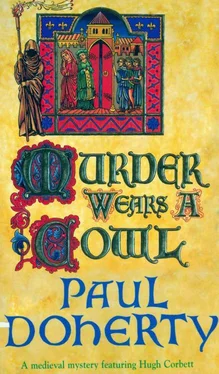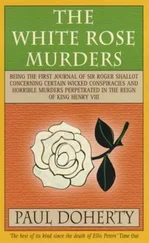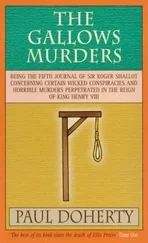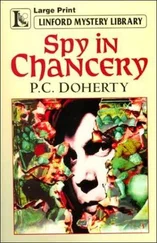Paul Doherty - Murder Wears a Cowl
Здесь есть возможность читать онлайн «Paul Doherty - Murder Wears a Cowl» весь текст электронной книги совершенно бесплатно (целиком полную версию без сокращений). В некоторых случаях можно слушать аудио, скачать через торрент в формате fb2 и присутствует краткое содержание. Год выпуска: 2012, ISBN: 2012, Издательство: Headline, Жанр: Исторический детектив, на английском языке. Описание произведения, (предисловие) а так же отзывы посетителей доступны на портале библиотеки ЛибКат.
- Название:Murder Wears a Cowl
- Автор:
- Издательство:Headline
- Жанр:
- Год:2012
- ISBN:9780755350346
- Рейтинг книги:5 / 5. Голосов: 1
-
Избранное:Добавить в избранное
- Отзывы:
-
Ваша оценка:
- 100
- 1
- 2
- 3
- 4
- 5
Murder Wears a Cowl: краткое содержание, описание и аннотация
Предлагаем к чтению аннотацию, описание, краткое содержание или предисловие (зависит от того, что написал сам автор книги «Murder Wears a Cowl»). Если вы не нашли необходимую информацию о книге — напишите в комментариях, мы постараемся отыскать её.
Murder Wears a Cowl — читать онлайн бесплатно полную книгу (весь текст) целиком
Ниже представлен текст книги, разбитый по страницам. Система сохранения места последней прочитанной страницы, позволяет с удобством читать онлайн бесплатно книгу «Murder Wears a Cowl», без необходимости каждый раз заново искать на чём Вы остановились. Поставьте закладку, и сможете в любой момент перейти на страницу, на которой закончили чтение.
Интервал:
Закладка:
‘Yes. Yes,’ Corbett murmured. ‘She is.’
Cade went over, filled two goblets of wine and handed them to Corbett and Ranulf. ‘I will leave you alone. When you have read them, then we will talk.’
Cade sauntered off, Ranulf turned to stare out of the window at a file of prisoners being led out into the yard below whilst Corbett studied the documents. The first two were letters informing the sheriffs of London how angry the King was that so many bloody murders had been committed in the city; in particular, the grisly death of Lady Somerville and the mysterious circumstances surrounding the fire which had killed Father Benedict. The next document was a memorandum drawn up, apparently by Cade himself, listing the number of women killed and, beside each of them, the date of their deaths. Corbett whistled under his breath. There were sixteen in all, excluding Lady Somerville. All the deaths had occurred within the city limits: as far west as Grays Inn; on the east Portsoken; Whitecross Street in the north; and as far south as the Ropery which bordered the Thames. Corbett also noticed how the murders had begun about eighteen months ago and were regularly spaced once a month, on or around the thirteenth day. The only exceptions were Lady Somerville who had been killed on the eleventh of May and the last victim, the whore found in a church near Greyfriars, murdered only two days previously. The whore was killed usually in her own chambers, although three, including the last, had been murdered elsewhere. All had died in the same gruesome manner: the neck slashed from ear to ear and the woman’s genitals mutilated and gouged with a knife. Again, the only exception was Lady Somerville who had been killed in Smithfield by a swift slash across the throat. Cade had also written that there was no other mark of violence and each whore’s dress was always neatly rearranged. Corbett stared at the memorandum then looked up.
‘A death every month,’ he murmured. ‘On or around the thirteenth.’
‘What’s that, Master?’
‘The whores: they were all killed around the same date, their throats slashed, their genitals mutilated.’
Ranulf made a rude sound with his lips. ‘What do you think, Master?’
‘Firstly, it could be some madman who just likes to kill women — whores especially. Secondly, it could be someone searching for a particular whore or-’
‘Or, what?’
‘Some practitioner of the black arts — magicians always like blood.’
Ranulf shivered and looked away. From his window he could see the towering mass of St Mary Le Bow, where Corbett had struggled and fought against a coven of witches led by the beautiful murderess Alice Atte-Bowe.
‘I don’t know,’ Corbett murmured and went on to read the memorandum on the death of Father Benedict: a short, caustic report from the coroner’s clerk. According to this, on the night of the twelfth of May, the monks at Westminster had been woken by the roar of flames and had rushed out to see Father Benedict’s house, which stood in a lonely part of the abbey grounds, engulfed in flames. The brothers, organised by William Senche, steward of the nearby Palace of Westminster, had tried to douse the flames with water from a nearby well but their efforts had been fruitless. The building was gutted except for the walls, and inside they found the half-burned corpse of Father Benedict slumped near the door, key in hand and, beside him, the remains of his pet cat.
There was no apparent cause of the fire. The shuttered window high in the wall had been open and a light breeze may have fanned the blaze caused by some spark from the fire or candle flame.
Corbett looked up. ‘Strange!’ he exclaimed.
Ranulf, half-watching the line of felons being manacled in the courtyard below, jumped.
‘What is, Master?’
‘Father Benedict’s death. The priest was an old man, Ranulf, and therefore a light sleeper. He gets up in the middle of the night, disturbed by a fire which has mysteriously started. He’s too old to climb out of the window so he grabs the key, reaches the door but never opens it. What is stranger still, is that his cat dies with him. Now, a dog might stay with his master but a cat would leave, jump out, especially as the window was open, yet the cat also dies.’
‘It could have been overcome by smoke,’ Ranulf suggested.
‘No.’ Corbett shook his head. ‘I can’t understand how a man could reach the door, have the key in his hand, yet not struggle for a few seconds more to insert the key and turn it. Yet, it’s the cat which really puzzles me more. The few I have known remind me of you, Ranulf. They have a keen sense of their own survival and a particular horror of fire.’
Ranulf looked away and pulled a face. Corbett went back and studied Cade’s scribbles on the bottom of the memorandum. According to the under-sheriff, earlier on the day he died Father Benedict had sent a short letter to the sheriff saying that he knew something terrible and blasphemous was about to happen but that no further details were available. Corbett shook his head and looked at the last, greasy, tiny scrap of parchment. A short report from a government informer about rumours of the master counterfeiter, Richard Puddlicott, being seen in Bride Lane near the Bishop of Salisbury’s inn. Corbett tapped the parchment against his knee and stared at the dirty rushes on the floor. So many mysteries, he wondered, but Puddlicott really intrigued him. The King’s messengers had been pursuing the villain all over Europe, so what was he doing in England? Was his presence linked to these deaths? Or was he in London for some other nefarious purpose? Either for his own or for Amaury de Craon’s? Corbett sat lost in his own thoughts, sipping his wine until Cade returned.
‘Did you find the papers interesting, Corbett?’
‘Yes, I did. You have no clues to the murderer of the whores?’
‘None whatsoever.’
‘And Lady Somerville?’
‘She was returning with a companion from a meeting of the Sisters of St Martha at Westminster. They went along Holborn and stopped for a while at St Bartholomew’s Hospital. Lady Somerville then announced she would slip across Smithfield to her house near the Barbican. Her companion objected but Lady Somerville just laughed. She said she was old and, being involved in her good works, was well known to all the rogues of the underworld who, therefore, would not accost her.’ Cade shrugged. ‘Lady Somerville had one son who had been out roistering with friends. He returned in the early hours, discovered his mother had failed to return and organised a search. His servants found her body near the gallows in Smithfield, her throat cut from ear to ear.’
‘But no other mutilations on the corpse?’
‘None whatsoever.’
‘Before her death was Lady Somerville distressed or anxious?’
‘No, not really.’
‘Exactly, Master Cade.’
The under-sheriff hid his irritation. ‘Well, one of her companions claimed she was withdrawn and kept muttering a certain proverb.’
‘Which is?’
‘ Cacullus non facit monachum ; the cowl doesn’t make the monk.’
‘What did she mean by that?’
‘I don’t know. Perhaps it was a reference to another of her charitable duties.’
‘Which was?’
‘She often laundered the robes of the monks at Westminster. You see their abbot, Walter Wenlock, is ill. The prior is dead so Lady Somerville often supervised the abbey laundry.’
Corbett handed back the sheaf of parchments.
‘And Father Benedict’s death?’
‘You know what we did.’
‘Strange, he didn’t unlock the door?’
‘Perhaps he was overcome by the smoke, or his robe caught fire?’
‘And the cat?’
Cade leaned against the wall and tapped his foot on the floor. ‘Master Corbett, we have corpses all over London and you ask me about a cat?’
Читать дальшеИнтервал:
Закладка:
Похожие книги на «Murder Wears a Cowl»
Представляем Вашему вниманию похожие книги на «Murder Wears a Cowl» списком для выбора. Мы отобрали схожую по названию и смыслу литературу в надежде предоставить читателям больше вариантов отыскать новые, интересные, ещё непрочитанные произведения.
Обсуждение, отзывы о книге «Murder Wears a Cowl» и просто собственные мнения читателей. Оставьте ваши комментарии, напишите, что Вы думаете о произведении, его смысле или главных героях. Укажите что конкретно понравилось, а что нет, и почему Вы так считаете.












